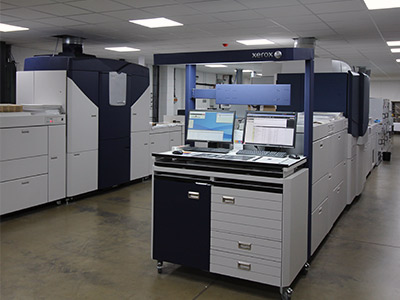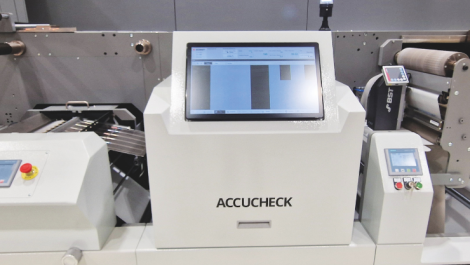In a world first, Qualvis now has a double digital packaging line at its Leicester home
Building on its decades of experience in folding cartons, Qualvis Print & Packaging has added digital to its repertoire in the form of two Xerox presses. Neel Madsen visited the company in Leicester.
With roots in a small, one-man band operation from the early 1970s, Qualvis Print & Packaging is today a family-owned company with a £13 million turnover. It serves mainly the food, confectionary and multimedia sectors, including big retailers, such as M&S, Tesco and Sainsbury’s, and a wide variety of well-known brands, including John Frieda, Maldon Sea Salt and Dorset Cereals.
Traditionally a litho printer, the company now also offers digitally printed cartons and sleeves following a large investment programme of £2 million in a fully-fledged digital department, with not one, but two, press lines under one roof. Within just three months of signing a deal for two Xerox iGen presses, Qualvis was in full operation delivering the first digital cartons to customers.
In the family
Qualvis, in its current format, was founded in 1982 when Jason’s father, David Short, joined Bob Lonsdale, who had a small printing company offering two-colour work to the trade. Mr Short had studied printing all over the world during his time playing professional football for Chelsea as the club insisted on giving its players a trade outside the game. This knowledge gave him the opportunity to work as a problem-solver when he retired from football and returned to the UK, before finally settling at Qualvis.
Despite having other plans, Jason Short started working in the warehouse at the company in 1985 to pay off debt accrued during a gap year travelling. He soon came to realise that there was good money to be made in print and started as a print operator. He later moved into sales and advanced to sales director, before taking over as managing director in 2006. He is also the current vice-chairman of BPIF Cartons.
The company moved to its premises in Thurmaston in 2011 and employs just over 100 staff. It continues to invest in the litho side of the business, most recently spending £2.7 million on a seven colour KBA Rapida press, which is currently being installed to run alongside an existing Heidelberg Speedmaster.
Why digital?
In February this year, the company was ready to reveal its new digital department. So what prompted this new venture? Jason Short explained, ‘I recently completed a course in business and leadership management at Cranfield University and my dissertation concluded that unless we took steps to change, Qualvis would have a limited shelf life. I realised that we had to find another string to our bow if we were to compete with the multinational groups and their endless resources.’
The first course of action was to investigate setting up a company in Scotland to serve customers there more efficiently by cutting delivery times, but it quickly became apparent that the figures did not add up due to the price sensitivity of the market and the plan was shelved. Plan B was to invest in digital.
When entering into a completely new area of print technology, a lot of support is needed and Mr Short put his trust in Xerox Platinum Partner, Advanced Business Equipment, which supplied all equipment and software, managed the building project, identified staff needed and the training of them. He said, ‘Over about 18 months, we looked at a number of options before making our final choice. The team at Advanced offered the whole package – infrastructure, skills and know-how – and Adele Cable and Phil Tucker were instrumental in our decision to purchase the Xerox iGens and Automated Packaging Solution and Advanced Software and Automation solutions. The support has also been invaluable in creating a sales and marketing strategy for digital.’
A section of the warehouse was quickly transformed into a standalone unit with three staff dedicated to the new department, Qualvis Digital. Production manager Nick Seville already had a background in digital, gained before joining the company and training as a litho printer. Account manager Emma Manton, who has 14 years’ experience in commercial digital print, was brought in especially for the project, while another new employee, James Smith, was trained to operate the presses and finishing kit.
Double delight
The double set up in the digital department means that downtime can be reduced to a minimum, with each press acting as a back up to the other.
The Xerox iGen 5 prints in five colours, as it has been fitted with the optional fifth colour station to reach a larger share of the colour gamut. It also features the Thick Stock modification, which means board up to 610 microns can be printed. Stock size maximum is 364 x 660 mm and resolution 2400 x 2400 dpi. The iGen 4 prints in four colours on the same media specs. Colour management is handled by Oris technology to ensure the print complies with Fogra 39L.
Both presses are configured with Tresu Pinta coaters running inline to offer water-based and UV coatings. These use flexo sleeve technology for quick changeovers and set the production speed at 3000 sheets per hour. Offline stands a Kama ProCut 76 flatbed die-cutter with Braille and embossing options, which runs at speeds up to 5000 sheets per hour, processing sizes up to 600 x 760 mm.
Importantly for Qualvis, whose main output is cartons and sleeves for food products, the presses use food-safe toners, have passed low migration testing, and are FDA and Swiss Ordinance approved. The whole site is also certified nut-free to meet the stringent Nestlé standard.
The company plans to introduce fulfilment, particularly for confectionary, for the digital business. It will also provide e-commerce solutions for its clients, including video integration technology, allowing brands and retailers to engage with customers and direct further marketing campaigns to them as a result of data capture.
Ready for the challenge
While Qualvis has successfully produced several digital jobs already, customers need educating to understand how they can benefit from less waste and faster delivery through the agility of digital printing. Mr Short said, ‘There is a huge amount of scappage each year. That is just the nature of the industry; cartons are printed but never used due to changes in design or orders being amended. This incurs high warehouse costs too, so the potential for savings is big.’
As another example of an area where digital can leverage its inherent benefits for cartons, he pointed to the problem suppliers and retailers face when dealing with seasonal food products, such as barbecue ranges. The short lead times of digital can eliminate the problem of trying to assess demand during the UK’s always-unpredictable summers. If the weather forecast says sun at the weekend, more cartons and sleeves can be printed on demand and the products be on shelf within a matter of days.
Mr Short said, ‘Run lengths are getting shorter and we are experiencing increasing demand for innovation from our customers, including personalisation and localisation. The market is moving faster, orders are changed and having the ability to offer just-in-time production is essential.’
Having spoken to Alexir Packaging’s managing director, Robert Davison, who is the chairman of BPIF Cartons, Mr Short was aware of the pitfalls to avoid and felt ready to take on this new challenge. He said, ‘We took a big leap of faith and this year will be a steep learning curve, but sometimes you just have to do it. I have no doubt that digital was the right solution, at the right time, and that we are ahead of the curve.’
He concluded, ‘Our approach to offering new technologies will take our company to a new level in our customers’ eyes. The focus is on how we can use technology to make our customers more profitable – if they are, we are, so it’s a win win.’






